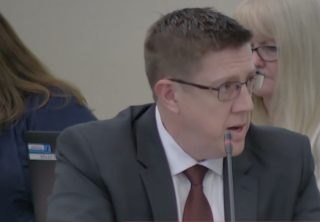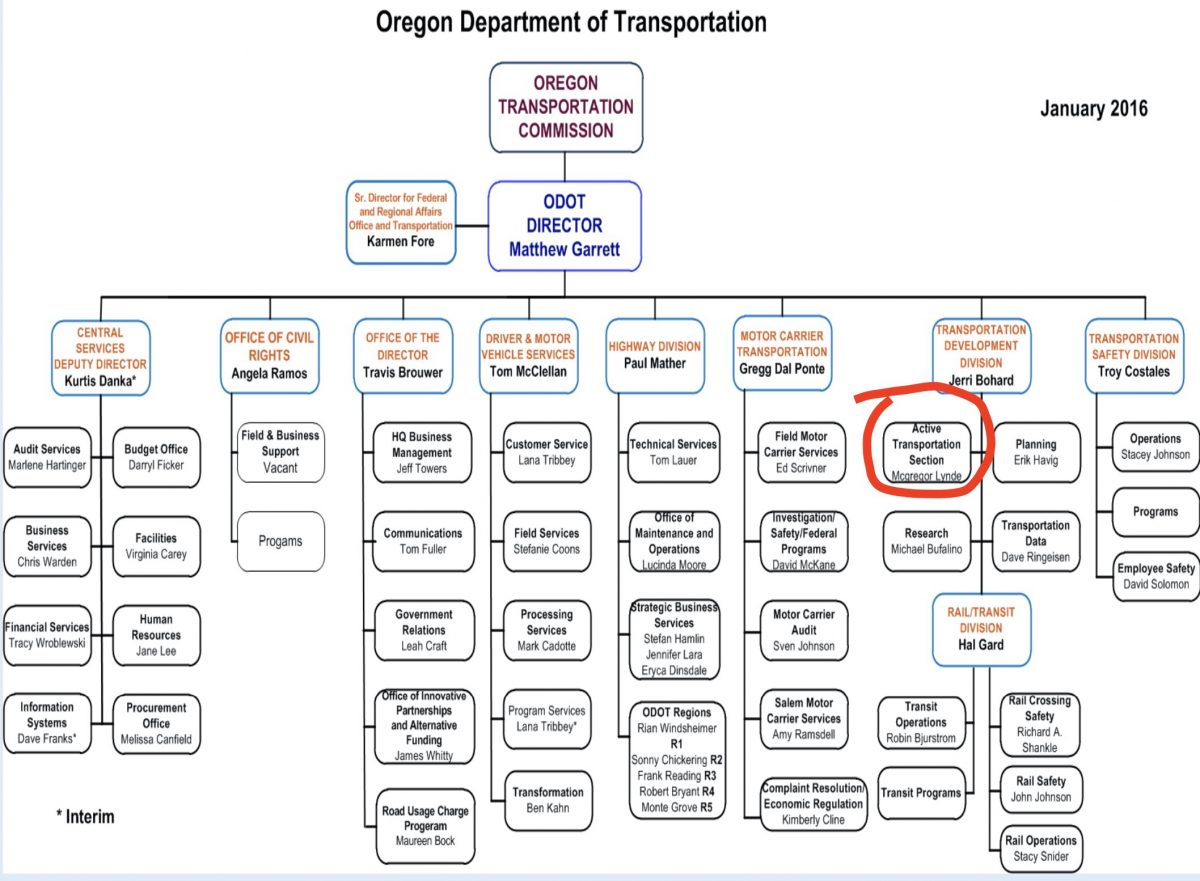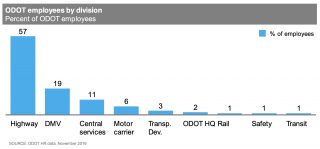

(Photo © J. Maus/BikePortland)
The Oregon Department of Transportation’s new assistant director is a former Marine who has worked for the U.S. Department of Defense and NATO. And the Highway Division is dead.
Those are just two of the interesting tidbits from a host of changes that quietly went into effect Monday following the Oregon Transportation Commission’s approval of a significant organizational restructuring spearheaded by new ODOT Director Kris Strickler.
Strickler was approved by the Oregon Senate less than a month ago and has wasted no time putting his stamp on the 5,000-plus employee agency that’s in charge of Oregon’s transportation system.
Speaking to the OTC on Monday, Strickler said the changes come in large part to address the “significant workload” facing the agency in its efforts to carry out HB 2017, the landmark package of projects, programs, and new taxes passed by the Oregon Legislature in 2017. In asking the OTC to approve the changes, Strickler also referred to a, “Rapidly changing environment of connected autonomous vehicles and new technology coming into the industry that force us to adapt and be prepared for a future that isn’t here yet.”
Advertisement

“Oregon is in the midst of tremendous change in the form of historic and unprecedented investments in the range of transportation choices being offered to Oregonians and in the development of new methods for financing those investments,” Strickler wrote in an all-staff memo (PDF) on December 12th. In addition to what he says will lead to a more nimble agency by delegating decision-making among four new assistant directors, Strickler has taken the opportunity to create a new position for social equity (to help the agency “look more like the communities we serve”) and reshuffle and rename key divisions.
The four new high-level positions include: Director of Operations; Director of Government & External Relations; Director of Revenue, Finance & Compliance, and Director of Social Equity. These directors will serve directly under Strickler. Three of the positions have already been filled. Cooper Brown will head up Operations, Lindsay Baker is the new leader of Government & External Relations, and Travis Brouwer is in charge of Revenue, Finance & Compliance.

Cooper was formerly the chief of staff for the Oregon Transportation Commission. Before coming to Oregon in summer of 2018 he worked for the Under Secretary of Defense Police in the Pentagon. He will now oversee all of ODOT’s modal divisions which have been renamed and restructured (more on that below).
Baker has worked for the State of Oregon for many years, including three years in various policy and communication roles at the Oregon Legislature.

(Photo: ODOT)
Brouwer has been at ODOT for 15 years and has served as assistant director for five.
Director Strickler says these new positions are part of a strategy to, “Add bandwidth at the leadership level
Director Strickler says the key goal of his re-org is to, “integrate the agency across division boundaries.” To achieve that he has re-named and shuffled divisions.
Advertisement

There’s no longer a Highway Division at ODOT. It’s now the Delivery and Operations Division. There’s no longer a Transportation Development Division. It’s now the Policy, Data, and Analysis Division. There’s no longer a Rail and Public Transit Division. It’s now the Public Transportation Division.
Strickler says he changed the name of the Highway Division, “To better reflect its role delivering projects and operating across all modes — not just roads.”

Speaking of all modes, I’ve confirmed with ODOT that the Bicycle and Pedestrian Program has been moved into the newly named Public Transportation Division. ODOT spokesperson Tom Fuller shared via email that, “We are trying to build more connections between public transportation like Passenger rail and transit and Active Transportation like Bike/ped.”
As with any large bureaucracy — especially one with a history of marginalizing everything except driving and highway widening — where staff are located and who they report to is one measure of their institutional respect (or lack thereof). As the chart at right shows, ODOT’s structure has always been heavily tilted toward delivery of large highway expansion projects.
Advertisement
“The most realistic expectation is that under Kris it will be a much more competent and well-managed state highway agency, but not a transformed one.”
— David Bragdon, former Metro president
A stronger effort on social equity is also part of these changes. Strickler has yet to hire someone to be the new Director of Social Equity, but when he does the person will lead a group whose sole focus will be to make sure, “That diversity and inclusion are embraced and integrated throughout the department.”
During Monday’s OTC meeting Strickler said the social equity director will, “Improve alignment of our transportation decisions within those communities that we’ve historically maybe not always made the best decisions in” and to, “Bring our level of awareness to a place where, frankly, all of us have an opportunity to grow.”
Former Metro President (now head of Transit Center in New York City) David Bragdon has been a vociferous critic of ODOT for years and worked with Strickler when the latter was head of the Columbia River Crossing project for Washington’s DOT. Bragdon respects Strickler and thinks he can bring out much-needed changes. “I expect Kris will make ODOT a more competent state highway agency, and he will get a handle on the chronic cost overruns and the cronyism,” Bragdon shared with me via email today. Then he added a note of caution, “Making it a better state highway department is certainly a good thing, but I doubt Kris or anyone else is likely to reform it into anything other than a highway agency, because moving boxes around the org chart doesn’t change the reality that their assets and headcount and budget and expertise are all about state highways, and always will be, no matter how you label it.”
“The most realistic expectation,” he continued, “Is that under Kris it will be a much more competent and well-managed state highway agency, but not a transformed one.”
Bragdon has reason to be skeptical. This isn’t the first time an ODOT director has tried a re-organization and promised big changes. In 2011 ODOT said the newly formed Active Transportation section would someday become its own division with equal footing to the Highway Division. That never happened. And in 2012, former ODOT Director Matt Garrett proclaimed at an active transportation summit that he had vanquished the Highway Division. He didn’t.
I’m still hoping to hear from more ODOT rank-and-file about the changes, but the ones I have talked to say much remains unknown. Beyond this restructuring, the agency is in the midst of vast changes: ODOT is in the process of creating a new, Portland-based Office of Mega Projects and hiring people to staff it; At Tuesday’s OTC meeting ODOT received support to move forward on their congestion pricing/tolling work and hire a new person to direct that effort; and employees are still getting used to having a new director after having the same one (Matt Garrett) for 14 years.
This is a critical time for ODOT: With so many new leaders and a cultural and political imperative to be more environmentally and socially conscious, they have an opportunity to finally move in a different direction. Time will tell what direction they choose.
— Jonathan Maus: (503) 706-8804, @jonathan_maus on Twitter and jonathan@bikeportland.org
— Get our headlines delivered to your inbox.
— Support this independent community media outlet with a one-time contribution or monthly subscription.





Thanks for reading.
BikePortland has served this community with independent community journalism since 2005. We rely on subscriptions from readers like you to survive. Your financial support is vital in keeping this valuable resource alive and well.
Please subscribe today to strengthen and expand our work.
As ODOT rank and file I unfortunately learn more here than I do in official communication channels. Keep up the good reporting!
Hang on. ODOT spokesperson Tom Fuller says the Bicycle and Pedestrian Program has been moved into the newly named Public Transportation Division… “to build more connections between public transportation like Passenger rail and transit and Active Transportation like Bike/ped”? 99.999% of ped and bike trips aren’t and never will be getting to/from a bus or train. Is ODOT burying ped/bike instead of giving it the needed boost?
Pretty sure he’s saying “connections” as in admin/planning/staff, not as in actual, physical connections.
Office of MEGA Projects? Why is ODOT still pursuing MEGA projects?
Small is Beautiful.
Reorganization gives the appearance of change. Actual change involves more than a change in who you report to.
I think moving the bicycle and pedestrian functions into the public transportation division reflects the funding structure or funding they may intend to commit to bicyclist and pedestrian improvements. The crashes on the highways that kill, disable and injure cyclists and pedestrians occur because there wasn’t enough planning for them in the highway development process. This is a bad move.
Huh. So if there’s now a “Public Transportation Division”, I guess the rest of the agency serves as the “Private Transportation Division”?
Hoping that this social equity position pushes ODOT to listen more to people instead of lobbyists. True social equity would require a lot less top down decision making and more bottom up. Not sure if this reorganization will accomplish this but maybe?